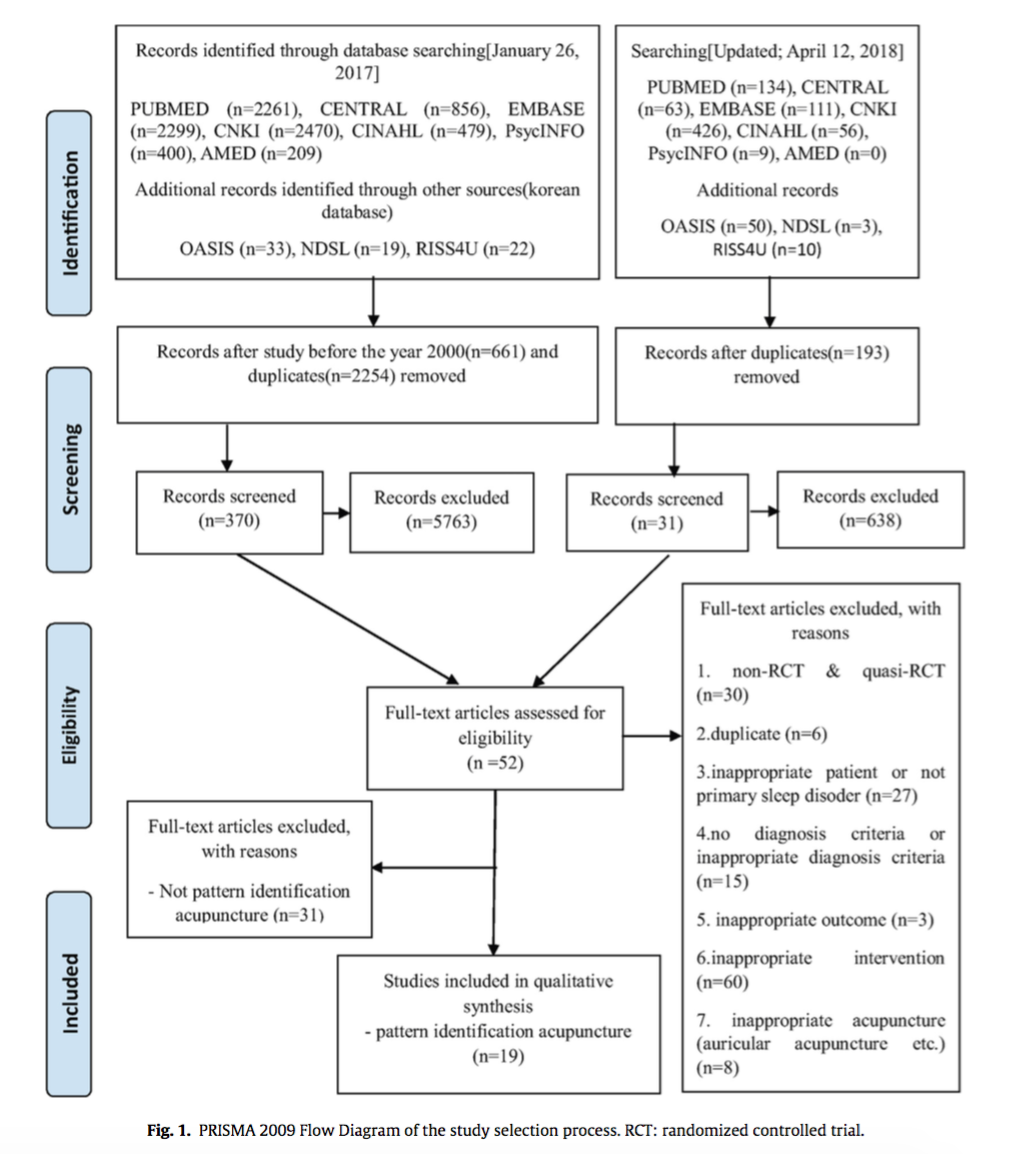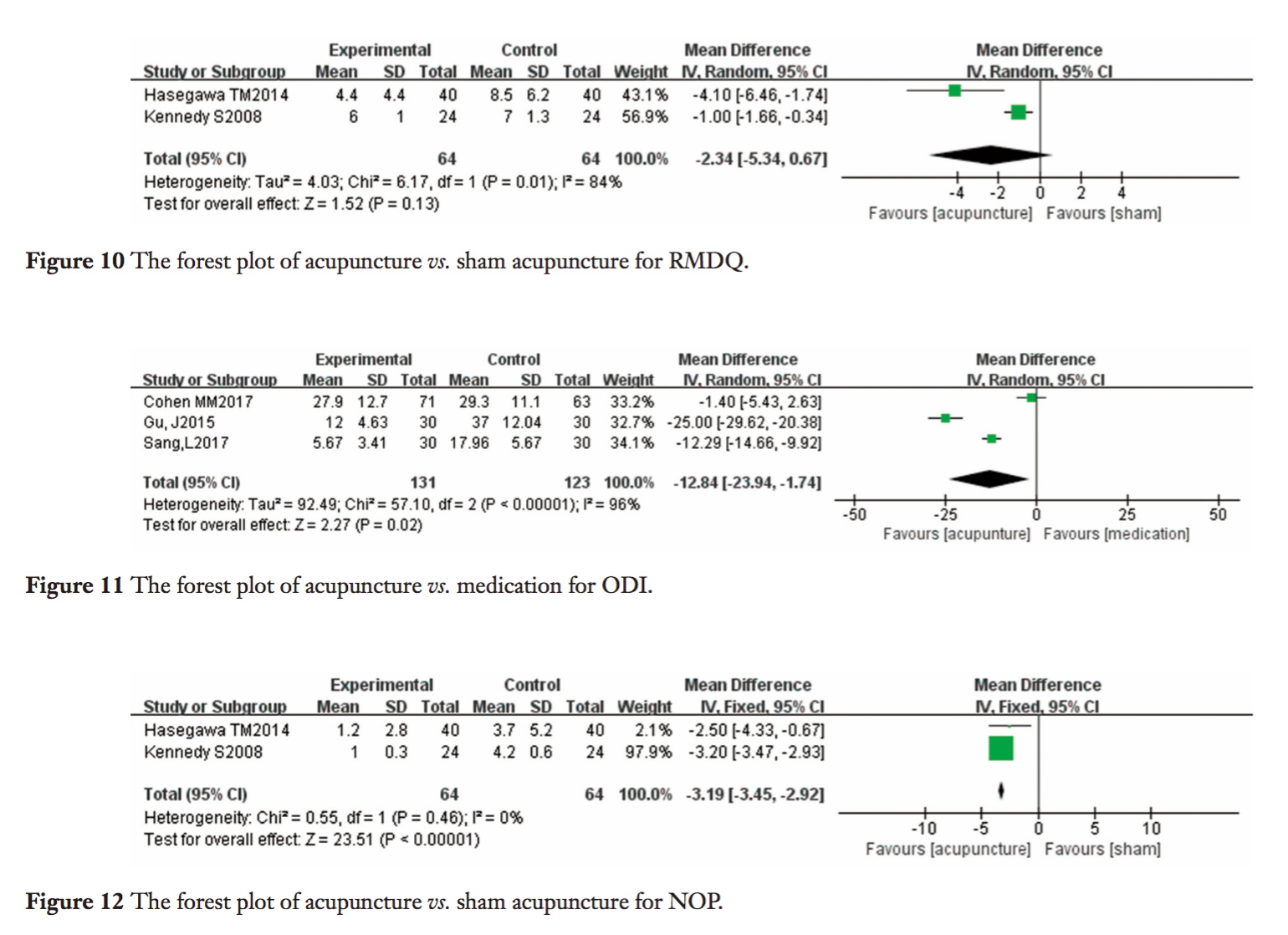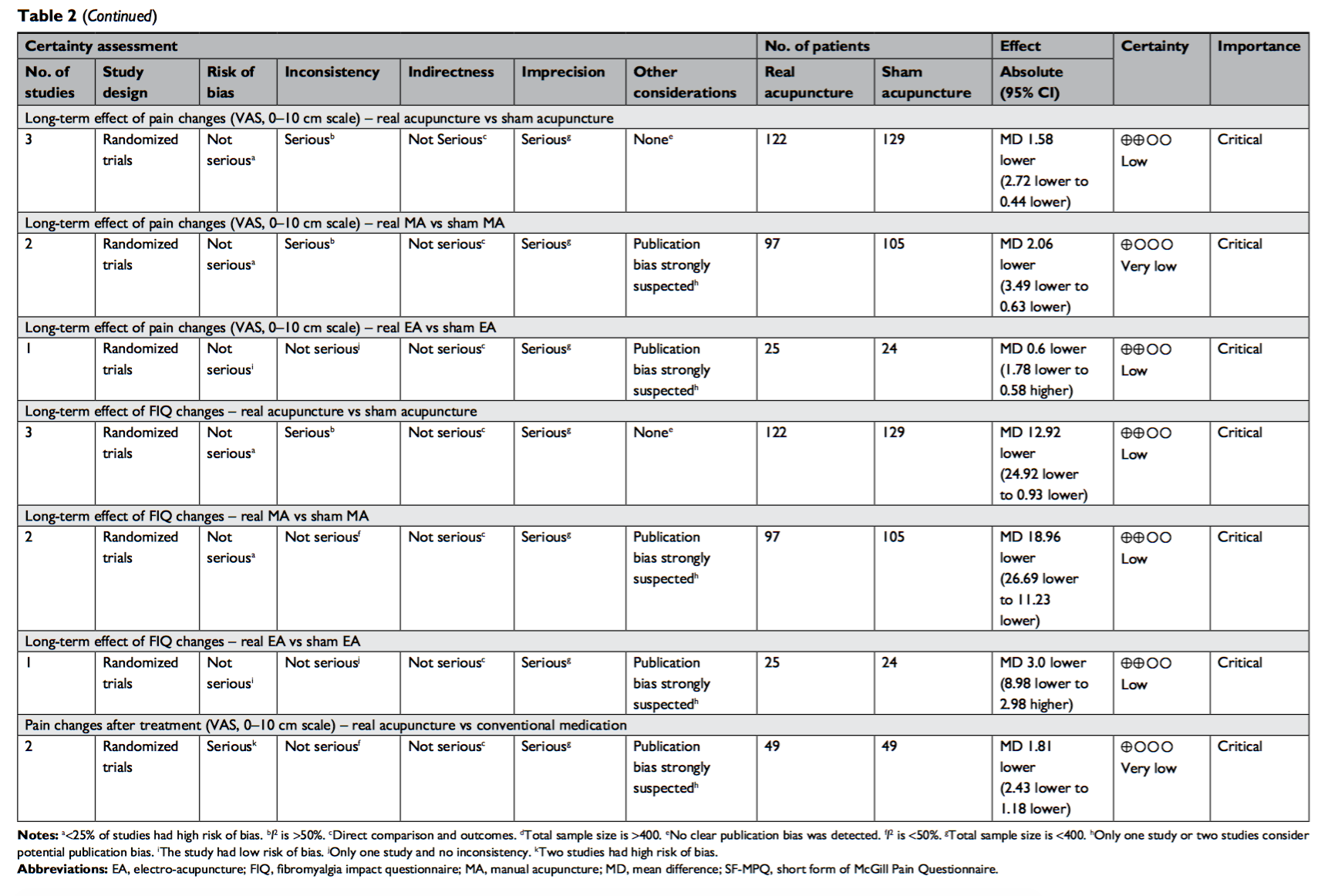
BLOG
Review: Acupuncture using pattern-identification appears to be effective in the treatment of insomnia
Kim, S. H., Jeong, J. H., Lim, J. H., & Kim, B. K. (2019). Acupuncture using pattern-identification for the treatment of insomnia disorder: a systematic review and meta-analysis of randomized controlled trials. Integrative medicine research, 8(3), 216–226.
https://doi.org/10.1016/j.imr.2019.08.002
QUESTION
Is acupuncture using pattern-identification effective in the treatment of insomnia?
DATA SOURCES
Randomized controlled trials (RCTs) were identified by searching PubMed, Cochrane CENTRAL, EMBASE, CINAHL, PsycINFO, CNKI, OASIS, NDSL, and RISS4U (from Jan 1, 2000 to April 12, 2018).
STUDY SELECTION
Randomized controlled trials (RCTs) that evaluate the effect of acupuncture and electroacupuncture, without regard to frequency or length of treatment, in patients diagnosed with primary insomnia were included (Fig 1).
DATA EXTRACTION
Two authors independently screened the studies and extracted data. Risk of bias evaluated using the Cochrane Collaboration’s risk of bias tool. Statistical analysis was performed using Review Manager version 5.3.
MAIN RESULTS
Meta-analysis showed that acupuncture significantly improved response rate and PSQI compared to medication.
CONCLUSION
Acupuncture using pattern-identification appears to be effective in the treatment of insomnia.
COMMENTARY
Authors identified 19 RCTs that address the question (Table 1). Sample size ranged from 25 to 192. Intervention in the treatment group of 11 studies was manual acupuncture and 8 studies was electroacupuncture. Interventions in the control group included medication, no treatment, and sham acupuncture. The primary outcome included response rate and Pittsburgh Sleep Quality Index (PSQI). Included studies were rated as low quality, overall risk of bias assessments were unclear or high, and publication bias was present.
Total of 16 pattern-identifications were used (3-7 pattern-identifications in each study). The most frequently used pattern-identification was “Deficiency of Heart and Spleen” (commonly used acupoints: SP-6, ST-36, BL-15, BL-20) and the most frequently used acupoints were GV-20, Si Shen Cong, An Mian, HT-7, and SP-6.
The result of 19 studies showed that the acupuncture group had a greater improvement in response rate than the medication group (Fig A). The result of the subgroup analysis showed that both acupuncture and electroacupuncture had a greater improvement in response rate than the medication group.
The result of 8 studies showed that the acupuncture group had a greater improvement in PSQI than the medication group (Fig B). The result of the subgroup analysis showed that both acupuncture and electroacupuncture had a greater improvement in PSQI than the medication group.
Authors conclude that “acupuncture using PI [pattern-identification] improved response rate and sleep quality compared with medication,” and suggest that, due to high risks of bias, clinical heterogeneity, and non-standardized pattern-diagnosis-criteria and acupoints, “further research comparing acupuncture using PI” is needed.
Review: Acupuncture is effective in the treatment of acute low back pain
Su, X., Qian, H., Chen, B., Fan, W., Xu, D., Tang, C., & Lu, L. (2021). Acupuncture for acute low back pain: a systematic review and meta-analysis. Annals of palliative medicine, 10(4), 3924–3936.
https://doi.org/10.21037/apm-20-1998
QUESTION
Is acupuncture effective in the treatment of acute low back pain?
DATA SOURCES
Studies were identified by searching the Allied and Complementary Medicine Database (AMED), the Cochrane Central Register of Controlled Trials, Embase, Medline, the China National Knowledge Infrastructure database (CNKI), the Wanfang database, and the Chinese Science and Technology Periodicals database (VIP) (up to May, 2020).
STUDY SELECTION
Randomized controlled trials (RCTs) concerning acupuncture for treating acute (≤12 weeks) low back pain of participants aged ≥18 years were included, while conference papers, systematic reviews, case reports, research protocols, and experimental animal studies, studies with incomplete data were excluded (Fig 1).
DATA EXTRACTION
Two authors independently screened the studies and extracted data. Risk of bias was independently assessed using the Cochrane tool and the consistency evaluation of risk of bias assessment was examined using the kappa coefficient. Statistical analysis was performed using Review Manager version 5.3.
MAIN RESULTS
Meta-analysis showed moderate-quality evidence that acupuncture has a statistically significant association with improvements in VAS, ODI, and NOP, but not RMDQ.
CONCLUSION
Acupuncture is effective in the treatment of acute low back pain.
COMMENTARY
Authors identified 13 RCTs that address the question (Table 1). Sample size ranged from 20 to 71. Interventions in the treatment group included manual acupuncture, electroacupuncture, beryllium acupuncture, wrist-ankle acupuncture, Fu’s acupuncture, and Yamamoto’s acupuncture. The interventions in the control group were sham acupuncture and pharmacotherapy. The primary outcome included the visual analogue scale (VAS) and the secondary outcomes included the Roland-Morris Disability Questionnaire (RMDQ), the Oswestry Disability Index (ODI), and numbers of pills (NOP). Among the 13 studies, 5 were rated as high quality and 8 as low quality.
The result of 11 studies showed that the acupuncture group had a greater improvement in VAS than the control group (Fig 4).
The result of the subgroup analysis showed that acupuncture had a greater effect on VAS than sham acupuncture and drug (Fig 5); acupuncture given once a day, once for 2 days, and twice for 3 days between 1 day and 2 weeks, and once or twice a week for 2 weeks or more had a greater effect on VAS than control group (Fig 6); both local and distal acupoint selection had a greater effect on VAS than control group (Fig 7).
Secondary outcome (RMDQ, ODI, NOP) results are below (Fig 10).
Authors conclude that “acupuncture treatment was associated with modest improvements in the VAS score, ODI score, and NOP, but not with improvement in RMDQ score in patients with acute LBP [low back pain],” and suggest that “high-quality trials are needed further to assess the role of acupuncture therapy for acute LBP.”
Review: Acupuncture is effective in the treatment of migraines and enhancement of the quality of life
Jiang, Y., Bai, P., Chen, H., Zhang, X. Y., Tang, X. Y., Chen, H. Q., Hu, Y. Y., Wang, X. L., Li, X. Y., Li, Y. P., & Tian, G. H. (2018). The Effect of Acupuncture on the Quality of Life in Patients With Migraine: A Systematic Review and Meta-Analysis. Frontiers in pharmacology, 9, 1190.
https://doi.org/10.3389/fphar.2018.01190
QUESTION
Is acupuncture effective in the treatment of migraines and the enhancement of the quality of life?
DATA SOURCES
Studies were identified by searching PubMed, the Cochrane Library, Web of Science, EMBASE, China Biology Medicine disc (CMB), China National Knowledge Infrastructure (CNKI), and the Wanfang Database (up to Oct 19th, 2017); manual searches of the references from the included literature and related systematic reviews.
STUDY SELECTION
Studies were selected if they were randomized controlled trials (RCTs) that compared an acupuncture group with a sham acupuncture or conventional medication group. 61 RCTs met the selection criteria (Fig 1).
DATA EXTRACTION
Two authors independently extracted and evaluated data. Risk of bias was assessed using the Cochrane risk of bias assessment tool. Statistical analysis was performed using RevMan 5.3 software.
MAIN RESULTS
Meta-analysis showed that acupuncture was significantly more effective in pain relief than medication, especially at follow-up times of up to 3 months after treatment, and more effective in pain relief and improved quality of life than sham acupuncture, especially at follow-up times of up to 3 months after treatment.
CONCLUSION
Acupuncture is effective in the treatment of migraines and enhancement of the quality of life.
COMMENTARY
Authors identified 61 RCTs that address the question. Sample size ranged from 22 to 302. Intervention in the treatment group was acupuncture. The interventions in the control group were sham acupuncture and conventional medication. The primary outcomes included Visual Analog Scale (VAS, from 0 to 10 scores), Migraine-Specific Quality of Life Questionnaire (MSQ), and frequency of migraine attacks (numbers/month). The secondary outcomes included total effective rate (the percentage of the total participants that showed symptom improvement ≥20%), days of migraine (days/month), and adverse events (numbers of adverse event attacks). Most of the studies were determined as low to moderate quality due to inadequate allocation concealment, reporting bias, heterogeneity, low sample size, and dropout without analysis. Characteristics of included studies can be found here.
The result of 12 studies (up to 1 month after treatment) and 2 studies (1 to 3 months after treatment) showed that the VAS score of the acupuncture group was significantly lower than that of the medication group, while the result of 2 studies (immediately after treatment) and 2 studies (3 to 6 months after treatment) showed that there was no significant difference in the VAS score (Fig A).
The result of 9 studies (up to 1 month after treatment) and 2 studies (1 to 3 months after treatment) showed that the VAS score of the acupuncture group was significantly lower than that of the sham acupuncture group, while the result of 2 studies (immediately after treatment), 2 studies (1 to 3 months after treatment), and 1 study (>6 months after treatment) showed that there was no significant difference in the VAS score (Fig B).
The result of 6 studies (up to 1 month after treatment) and 2 studies (1 to 3 months after treatment) showed that the MSQ scores (role function-restrictive, role function-preventative, and emotional function) of the acupuncture group was significantly greater than that of the sham acupuncture group, while the result of 1 study (> 6 months after treatment) showed that there was no significant difference (Fig 4).
The result of 1 study showed that the frequency of migraine attacks of the acupuncture group was significantly lower than that of the no treatment group. The secondary outcomes (total effective rate, days of migraine, and adverse events) can be be found here.
Authors conclude that “acupuncture is superior to no treatment, sham acupuncture and medication, both in terms of efficacy and safety. Acupuncture could be recommended as one of the effective therapies for migraine,” but also suggest that further studies are needed to “guide the operation of acupuncture for migraine, including the acupoints selection, the best course and frequency of treatment.”
Review: Acupuncture therapy is an effective treatment for patients with fibromyalgia
Zhang, X. C., Chen, H., Xu, W. T., Song, Y. Y., Gu, Y. H., & Ni, G. X. (2019). Acupuncture therapy for fibromyalgia: a systematic review and meta-analysis of randomized controlled trials. Journal of pain research, 12, 527–542.
https://doi.org/10.2147/JPR.S186227
QUESTION
Is acupuncture therapy an effective treatment for patients with fibromyalgia?
DATA SOURCES
Studies were identified by searching PubMed, the Cochrane Library, Embase, the China National Knowledge Infrastructure, the Chinese Science and Technology Periodical Database, and the Chinese Biomedical Literature Database (up to May 2018); manual searches of reviews related to fibromyalgia treatments.
STUDY SELECTION
Studies were selected if they were randomized controlled trials (RCTs) that compared an acupuncture group with a sham or conventional medication group. 12 RCTs met the selection criteria (Fig 1).
DATA EXTRACTION
One author performed searches. Two authors screened eligible studies, then independently extracted and evaluated data. Risk of bias was assessed according to the Cochrane risk of bias assessment tool. Quality of evidence was evaluated using the Grades of Recommendation, Assessment, Development and Evaluation (GRADE) Guideline Development Tool. Statistical analysis was performed using RevMan 5.3 software.
MAIN RESULTS
Meta-analysis showed that acupuncture was significantly more effective than sham acupuncture in reducing pain and improving the quality of life in both short and long terms. Acupuncture was significantly more effective than conventional medication in reducing pain in both short and long terms. There were no serious adverse events found during acupuncture.
CONCLUSION
Acupuncture therapy is an effective treatment for patients with fibromyalgia.
COMMENTARY
Authors identified 12 RCTs that address the question. Sample size ranged from 20 to 164 (Table 1). Interventions in the treatment group were acupuncture and electroacupuncture. The interventions in the control group were sham acupuncture, sham electroacupuncture, and conventional medication.
Although there was high performance bias, most of the studies were rated as low risks of bias. According to the GRADE system, most of the studies were classified as moderate to low quality while 1 study (long-term effect of VAS changes in acupuncture vs sham) and 2 studies (VAS changes after treatment in acupuncture vs conventional medication) were classified as very low quality (Table 2).
The result of the 9 studies showed that acupuncture was significantly better in reducing pain in terms of VAS (Fig A). The subgroup analysis showed that both acupuncture and electroacupuncture were significantly better than sham groups.
The result of the 2 studies showed that acupuncture and sham acupuncture were not significantly different in reducing pain in terms of SF-MPQ (Fig B).
The result of the 4 studies showed that acupuncture was significantly better in improving quality of life in terms of FIQ (Fig C). The subgroup analysis showed that acupuncture was significantly better than sham acupuncture while electroacupuncture was not significantly different from sham electroacupuncture.
The result of the 3 studies showed that acupuncture was significantly better in terms of long-term effect of VAS changes (Fig D). The subgroup analysis showed that acupuncture was significantly better than sham acupuncture while electroacupuncture was not significantly different from sham electroacupuncture.
The result of the 3 studies showed that acupuncture was significantly better in terms of long-term effect of FIQ changes (Fig E). The subgroup analysis showed that acupuncture was significantly better than sham acupuncture while electroacupuncture was not significantly different from sham electroacupuncture.
Total of 3 studies compared acupuncture therapy with conventional medication. The result of the 2 studies showed that acupuncture was significantly better in reducing pain in terms of VAS (Fig 4A). The result of the 1 study showed that acupuncture was significantly better in terms of long-term effect of VAS changes (Fig 4B).
Authors conclude that “acupuncture therapy is an effective and safe treatment for patients with FM [fibromyalgia], and it can be recommended for the management of FM. However, more large-sample RCTs are needed to investigate the therapeutic effect of EA [electroacupuncture] for FM in the long term.”
Review: Acupuncture therapy appears to be effective in decreasing preoperative anxiety
Tong, Q. Y., Liu, R., Zhang, K., Gao, Y., Cui, G. W., & Shen, W. D. (2021). Can acupuncture therapy reduce preoperative anxiety? A systematic review and meta-analysis. Journal of integrative medicine, 19(1), 20–28.
https://doi.org/10.1016/j.joim.2020.10.007
QUESTION
Is acupuncture therapy effective for preoperative anxiety?
DATA SOURCES
Studies were identified by searching the China National Knowledge Infrastructure Database, Wanfang Data Journal Database, Chinese Biomedical Literature Database, Chongqing VIP, Embase, PubMed, and Cochrane Library Databases (up to February 19, 2020); manual searches of conference abstracts and other reference lists.
STUDY SELECTION
Studies were selected if they were randomized controlled trials (RCTs) that compared an acupuncture group with a sham group. 12 RCTs met the selection criteria, containing a total of 916 patients (Fig 1).
DATA EXTRACTION
Data were extracted and evaluated independently by two researchers. Risk of bias was assessed according to Cochrane handbook 5.1.0 and the Standards for Reporting Interventions in Clinical Trials of Acupuncture (STRICTA). Quality of evidence was evaluated with the Grades of Recommendation, Assessment, Development and Evaluation (GRADE) system. Statistical analysis was performed using The RevMan 5.3 software.
MAIN RESULTS
Meta-analysis showed that the acupuncture group had reduced State-Trait Anxiety Inventory Scale (STAI-S) score and Visual Analogue Scale (VAS) score. There was no difference in the Hamilton Anxiety Scale (HAMA) score between the two groups.
CONCLUSION
Acupuncture therapy appears to be effective in decreasing preoperative anxiety.
COMMENTARY
Authors identified 12 RCTs that address the question. Sample size ranged from 21 to 62. Interventions in the treatment group were acupuncture, percutaneous electrical stimulation of acupoints, auricular acupressure, auricular acupuncture, and percutaneous electrical stimulation of auricular points. The interventions in the control group were sham acupressure, sham acupoints, sham auricular points, and preoperative routine nursing.
Unfortunately, a number of unclear risks of bias were present in the studies and the overall quality was relatively weak according to STRICTA criteria, for instance only 33% of studies reporting the treatment regimen. These are likely failings of the primary reports rather than the review process. According to the GRADE system, the STAI-S assessment was classified as moderate quality, the VAS assessment as low quality, and the HAMA assessment as very low quality (Table 4).
The result of the 5 studies showed the association between acupuncture therapy and the STAI-S score (Fig 3). Although substantial heterogeneity was present, combining similar interventions showed the reduction in heterogeneity with the same result. The result of the 4 studies showed the association between acupuncture therapy and the VAS score (Fig 4). Substantial heterogeneity was present and the sensitivity analysis indicated that the result was unstable. The result of the 2 studies showed that acupuncture therapy was not statistically different from sham therapy in terms of the HAMA score (Fig 5).
Authors conclude that “acupuncture therapy, compared to control groups or sham therapy, can decrease the STAI-S and VAS scores of preoperative anxiety in patients,” but “the reliability of these results needs to be further explored with a higher number of participants and greater quality of research.”




































